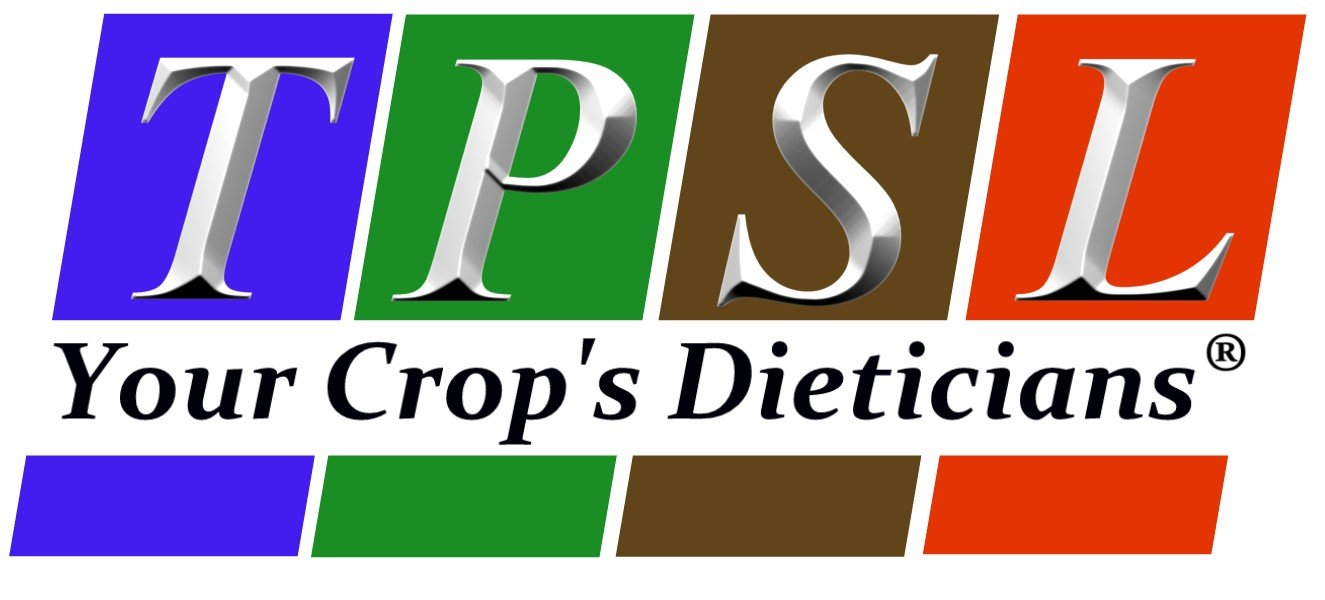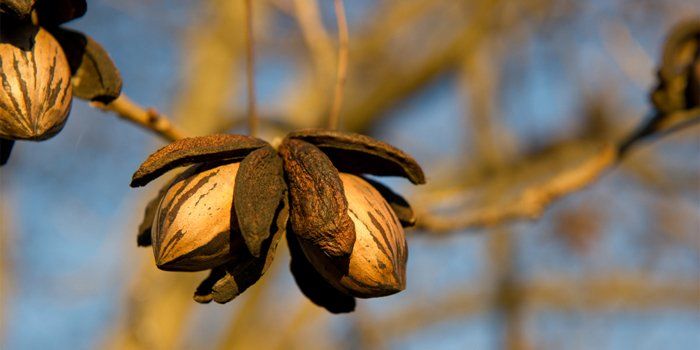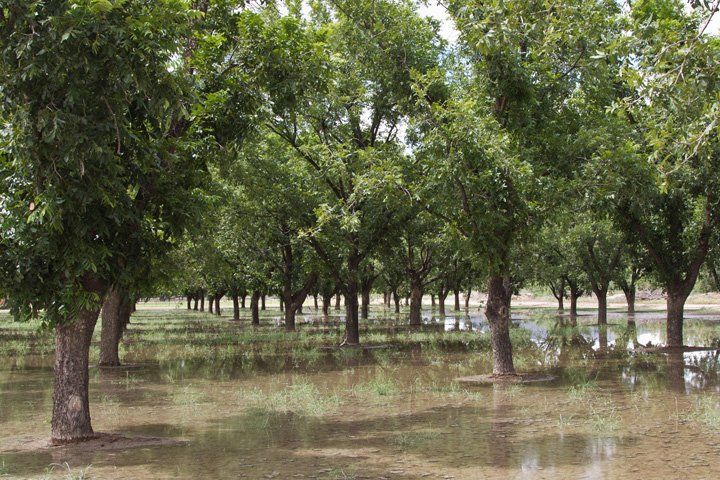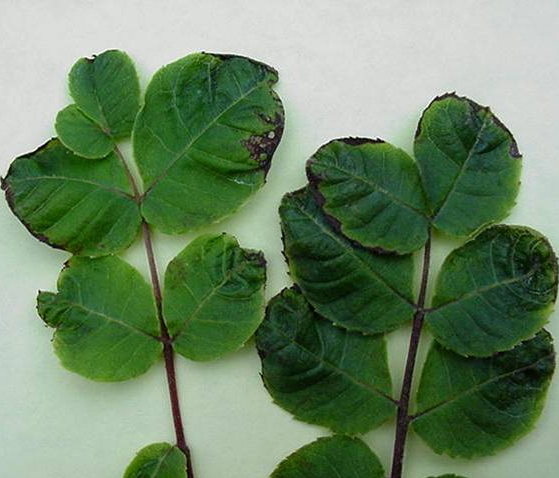General Cultivation and Nutrition
The pecan is one of the most popular of the large backyard shade trees but is of great commercial value as well, being cultivated on large and small scales for nut production. Native to America, pecans are commonly found along river bottoms in Midwestern, eastern and southern states. Both native and varietal selections are used for nut production. However, most often, and most profitably, grafted varietal types generally referred to as “papershell” are used for nut production. On a commercial scale, management can include marketing the valuable saw wood when underperforming trees need to be replaced.
There are very many grafted varieties from which to choose, some growing better in particular regions. Whether planted as an ornamental shade tree, or for nut production, the pecan must be managed with a good nutrition and irrigation plan to ensure it lives up to its double status as a beautiful tree that produces tasty, healthful nuts. This widespread appeal results in pecans being planted in varied soil and environmental conditions, reflecting the resilience of the tree. Despite their widespread adaptability, they often don’t do very well in areas where insufficient rainfall or poor soil drainage exists, and do much better when they receive adequate care. Nutritional issues with pecans go well beyond the usual N-P-K issues of growing other crops.
Anyone considering commercial production of pecans must be willing to monitor the trees and soil conditions to ensure the best possible production. Successful production practices are characterized by pro-active and continuous attention to the needs of the trees.
Starting Off Right
Good tree management starts with selecting the best location for the orchard. The best soils include deep sandy loams overlying clay (best for water storage). A site with good air drainage and surface water drainage is ideal, so look to hilltops and pastures for the best location. Proper planting techniques include a pre-plant soil test to determine which nutrients should be placed into the planting hole. These will normally include the major nutrients, Nitrogen (N), Phosphorus (P), Potassium (K), Calcium (Ca), Magnesium (Mg), Sulfur (S), and several “trace” elements, Zinc (Zn), Nickel (Ni), Iron (Fe), Boron (B), Copper (Cu), and Manganese (Mn). Don’t be fooled by the term, “trace”. Trees require these elements; they’re just needed in smaller amounts than other elements. Please refer to the nutrient deficiencies photos. Pecans do best in soils with a slightly acidic pH, around 6. The photo above attests to the durability of pecans. These are growing in tight, high pH (7.6), heavy clay blackland soil with little drainage. Many weeks can pass without rain. Nuts are poor or nil.
Mix the recommended nutrients with the soil removed from the hole. If planting multiple trees, make sure they are placed no closer than 50 feet from each other. For more tree planting guide information, please see the last pages of this paper. Pecans do not produce well if they are crowded and are often thinned once good establishment has been attained. Refer to the TPSL® Tree Planting Guide papers for more for details.
Briefly, make sure you buy trees with healthy root systems. Gently remove them from the container, remove from the roots as much of the container medium as possible, and spread out the lateral roots in the planting hole. Back fill completely, filling air pockets around the roots. Make sure the root flare, the first division of trunk into root, is positioned such that it will be above the soil surface when done.
Backfill with the native soil which has been mixed with the recommended fertilizers determined from soil test results. This is also the best, perhaps the only, time to inoculate the roots with ectomycorrhizal fungi to start the process of enhanced tree nutrition and health. Inoculating new planting stock will help to counter cotton root rot, a serious disease in many parts of the country.
Mycorrhizae (myco = fungus, rhizae = root) are symbiotic relationships that develop between most plants and certain soil fungi which greatly enhance root nutrient absorptive capacity and provide added protection from root diseases.
As more backfill is added and distributed in the hole, the tree will begin to support itself–make sure the tree trunk in straight and use loosely-tied guys to support it. Water the tree so that the soil never dries out during the critical establishment phase. Planting stresses the tree and it must be kept in moist (but not wet) soil to allow new roots to begin growing.
Water Needs
Native pecans are found most commonly along rivers, creeks, and streams. This suggests they grow best where soils are deep and water availability is stable. Develop a plan for frequent watering and follow it. Mature pecans need about 60 inches of water annually to thrive, so an irrigation system is often necessary to provide the needed water. Although pecan trees grow to enormous size and have deep roots, most of the water they use comes from the top three feet of soil, mostly from around and well beyond the drip line of the canopy. Deeper soil water is used mainly for survival in dry periods. It can seem overwhelming, but pecans need continuous access to water. Less water is needed for young trees, about 5 gallons per day, but this must be increased as the orchard matures. Monitor leaf health to watch for signs of overwatering. Leaves will begin to turn a dark color and wilt. Some irrigation technologies can accommodate liquid forms of fertilizer, allowing simultaneous irrigation and fertilization (“fertigation”)
Irrigation Technologies
As mentioned, pecans need a lot of water. Few serious growers can rely on rainfall to supply the large amount of water needed to satisfy tree needs. Using ground water or surface water resources, pecans may be irrigated by flooding the entire orchard, running water into the orchard by means of irrigation furrows, or by using sprinkler heads placed strategically in the orchard that distribute water from pressurized lines. Of these, one of the more favored technologies is drip irrigation. There are advantages and disadvantages of all irrigation systems. The one that works best in any particular situation will be determined by local conditions. With drip irrigation, low pressure water lines are distributed through the orchard and are fitted with emitters near trees to allow water to escape the line and enter the soil. Emitters commonly supply water at 2 gallons per hour, allowing a slow infiltration into the soil around the tree. This method is considered to be the most effective in conserving water resources. Micro-irrigation are “ground hugging” sprinklers that wet a larger area than drip emitters, and are popular for orchards on sandy soil. Lateral movement of water is not as great on sandy soil as on finer-textured soils, so Micro-irrigation can distribute water more evenly in sandy conditions.
Success with irrigation depends on how well the system is designed, installed, operated, and maintained. In addition, water quality problems can be a “deal breaker”. Water quality is unfortunately often overlooked in planning an irrigation system. It is vital to determine the quality of the water available for irrigation before embarking on the installation of an expensive irrigation system. Water may be salty, contain “hardness” chemical compounds such as calcium, magnesium, or iron and can have other conditions that can affect long term orchard productivity, such as carbonates. These conditions can severely limit or even prohibit use of a particular water source. Hence, it is best to determine water quality first by having it tested. It should be rechecked regularly, because quality can change over time and use.
Fertilization
How much fertilizer is needed in subsequent years is determined from soil and leaf testing. Soil testing may be necessary only every three years, but leaf testing, and petiole testing on fruiting tips should be done at least annually. July is often recommended as leaf testing month. Application of the N, P, K, Ca, Mg, and S is most often done via soil application of dry materials to the soil (if fertigation is not employed). The grower may choose to provide fertility by using conventional fertilizers, by adding only organic materials, or by a combination of the two. Compost may be applied in Spring to provide a slow, steady nutrient supply and to promote beneficial soil microbial activity. A combination of conventional fertilizers and compost can be used to satisfy the nutrient demands of the trees - with the compost providing a fertility foundation which can be supplemented with conventional fertilizers as needed.
Some of the major nutrients and trace elements can be applied foliarly. Good absorption of these nutrients (especially chelated trace elements) takes place when sprayed directly onto the leaves which bypasses potential problems with tie-up of trace elements in some low organic matter, high pH soils.
The soil’s capacity to provide nutrients to the trees will be improved over time if steps are taken to improve soil organic matter level and microbial activity in the orchard. This state is achieved by use of composts, cover crops and biological soil inoculants in the alleys of the orchard. The soil will reach a stage of improvement in which much of the tree nutrition will be taken care of biologically. This greatly simplifies the tasks of the grower and reduces fertilization costs.
Nutrients and Their Functions
When nutrient problems limit plant growth, it is often due to multiple nutrient deficiencies. Each nutrient is responsible for a main effect on plant physiology, but may also have a secondary rôle as well. The following discusses how nutrients are used, and of the sometimes overlapping activities of different nutrients in plant functions:
Nitrogen (N) is needed in large amounts and therefore most likely to be limiting plant growth. It is a main constituent of proteins, enzymes, and of the chlorophyll molecule, the light capturing molecule in leaves. Photosynthesis is greatly impaired where nitrogen is limited. Growth and reproduction can be substantially stunted when nitrogen available to the plant is limited.
Phosphorus (P) follows nitrogen in the amounts needed for good plant growth. It is used in photosynthesis. It is essential for seed and fruit development, synthesis of oils, sugars, starches, and is a structural part of nucleic acids, phospholipids, and ATP. Further, it is also involved in controlling basic enzyme reactions and in the regulation of metabolic pathways. Root development is dependent on an adequate supply of P and it contributes to stress resistance. It is needed for flowering as well.
Potassium (K) follows phosphorus in amounts needed for plant nutrition. It participates in protein production, photosynthesis, fruit quality and sugar transport, disease resistance.
Calcium (Ca) is part of plant cell wall structure, participates in nutrient transport into the cells, and is involved in stress adaptation. It also functions to counteract salt and organic acid accumulation in plants.
Magnesium (Mg) is used in the structure of the chlorophyll molecule and essential for photosynthesis. It also functions in many plant enzymes needed for growth.
Sulfur (S) is necessary for protein production. It also functions in photosynthesis, root growth, seed production, and helps alleviate some abiotic stresses on the plant.
Zinc (Zn) is used in carbohydrate production in plants and serves to regulate the movement of sugars within the plant. It is essential in plant growth regulation.
Nickel (Ni) is used in converting urea to ammonia via the urease pathway. Recent research has shown ‘mouse ear’ of pecan, which leads to leaf margin necrosis, is caused by a severe Ni deficiency
SEE SPECIAL WARNING ABOUT NICKEL AT THE END OF THIS PAPER!
Iron (Fe) Essential for formation of chlorophyll, hence is a central structural component in photosynthesis. It is also a structural part of other enzyme systems, synthesis of sugars and other carbohydrates, and is essential for flowering and fruit development.
Manganese (Mn) participates in plant metabolism as an activator of the enzymes involved in nitrogen uptake and incorporation.
Copper (Cu) is needed for chlorophyll and some enzyme reactions. It may be involved in enzyme synthesis, as well.
Chlorine (Cl) is needed for root and shoot elongation, and functions in photosynthesis.
Alternate Bearing
Alternate bearing is a significant production problem in pecans. There is not yet a complete picture of the reasons behind the phenomenon, but a large part of the problem is that the nuts contain a lot of oil, around 70% of them is lipid. It takes an enormous amount of energy to fill the nuts with lipids, much more than for other alternate bearing fruit trees that store mainly carbohydrates. Hence, alternate bearing appears to be much less a problem in citrus. Likely other contributors to alternate bearing include water, nutrient deficiencies, and weeds. Multiple stresses occur commonly, so several smaller “fixes” will help.
While it is likely that plant hormones play an important role in affecting flower initiation, they are likely responding to biochemical conditions in the plant at the time of flower initiation. As much of the tree’s energy reserves and carbohydrate production is being funneled to the developing nuts, to be turned into lipids, little is left to start next year’s nut crop by flower bud initiation. Nutritional intervention during fruit maturation and after harvest may reduce the stresses on the tree, allowing a better flower bud initiation for next year. Organic practices have been shown to reduce alternate bearing, probably by moderating nutrient and water stresses by improving the tree’s resistance to stresses.
Research points to a strong effect of the size of the carbohydrate pool in dormant trees on fruit development the next year. Other research supports this. Later maturing varieties, on which leaves are retained longer, appear to have better carbohydrate reserves due to late season photosynthesis. A soil and crop management plan that includes attention to the energy, nutrient, and water needs of trees following harvest appears to be a promising approach to reduce the tendency for alternate bearing.
Cover Cropping and Soil Building
Orchard management practices should include cultivating and maintaining a green orchard floor. The presence of a low-growing crop of grass or legume contributes to the health and productivity of the pecan trees above it. The most common configuration is a grass crop down the row middles that is maintained by mowing, while a plant-free zone is maintained under the trees with herbicides. The main purposes of the green strips are to keep down weeds, and to provide a traffic-accessible lane for spray applications and for harvest operations.
Planting a cover crop beneath the pecan canopy can improve the productivity and health of the pecan orchards and generally fulfills the Crimson Clover in a pecan orchard U.Ga. requirements for effective cover crops. Clovers are a common choice.
The contribution to tree nutrition occurs by the nutrient gathering capacity of the legume. When grown together, pecans and legume roots become intermingled. Legumes “fix” nitrogen from the air and, as nitrogen compounds are pushed out of the roots, the nitrogen can be transformed by other microbes into a form that can be absorbed by pecan roots. “Cross-feeding” is common among plant types, and using legumes in this manner is an effective way to provide some of the needed nitrogen for trees. The cover crop also “mines” nutrients from the soil and traps them in organic form. Later, as clover roots decay, those nutrients are released and taken up by the pecan roots in the vicinity. The transfer of Phosphorus, Calcium, Magnesium, and many other essential elements to the trees is facilitated by the association of different plant types.
Legume flowers also attract insects, many of which are predators of pecan pest insects. Providing refuge for beneficial insects contributes a biocontrol aspect to pecan production. Complete control may not always be achieved, but support of beneficial insects in the pecan orchard can help reduce chemical sprays to avert crop loss to insect pests.
As with any other crop, a cover crop needs to be managed properly. Clover and grass mixes can be maintained by grazing animals, or can be mowed and baled as a hay crop, adding another crop being produced from the pecan orchard. Cover crops provide a tidy appearance to the orchard and improve access to the traffic ways after a rain. Check locally for information on the best grasses and legumes to use in pecan orchards, as these will differ between the wide climatic ranges in which pecans are grown.
Cover crops are an important part of soil building that enhances the long-term health and productivity of orchards. Pecans respond very well to improvements made in soil quality. Building soil quality in centered on improving soil organic matter. Where soil organic matter is adequate, trees benefit from the increase in the size of the nutrient storehouse. This helps ensure the trees will have access to the nutrients and water they need throughout the growing season and help prevent nutrient deficiencies and the stress of inadequate water supply. Where soil organic matter is adequate, soil microbes control much of the processes providing nutrients to the trees. This natural relationship between trees and soils just seems to work better, not only for tree nutrition, but also for root disease suppression. Beneficial microbes grow actively in soils with adequate organic matter. They help control populations of pathogenic microbes that can cause root diseases of pecan.
Soil building starts with increasing organic matter inputs in the orchard. Composts, manures, compost teas can all be used to supply nutrients and combat diseases. Amending the soil with these organics on a regular basis will help turn the orchard over to the soil microbes. Over time, the improvements achieved with organic matter amendments will pay many times over in healthier, more productive pecans.
PLANTING SUGGESTIONS - SOME THINGS TO KEEP IN MIND.
NEVER USE “WEED & FEED” FERTILIZERS OR PRE-EMERGENT HERBICIDES ANYWHERE NEAR PECANS! CERTAIN PESTICIDES MAY CARRY OVER INTO THE NUTS!
Well-established pecan trees have feeder roots that can extend out to a radius well beyond twice the height of the tree.
The “conventional wisdom” concerning the canopy “drip-line” generally applies only to young trees.
When considering a location for a commercial operation, no less than correct soil pH range, soil physical qualities and water availability/quality are all essential!
We have many more free relevant and downloadable Agronomy Notes relevant to Pecans.
SPECIAL WARNING ON NICKEL
Nickel compounds, particularly water-soluble ones, are known to be highly carcinogenic to humans!
Nickel deficiency in pecans can occur in two ways:
1. The soil is deficient in water soluble (tree-available) Nickel compounds. The soil can also be deficient in any other [insoluble] Nickel compound. Generally speaking, Nickel becomes less available with increasing soil pH. It can also be made unavailable by excesses of other metals.
2. Zinc is especially successful in blocking Nickel uptake by the tree. Petioles or leaves that assay high in Zinc will almost certainly assay low in Nickel.
Adding Nickel is not the answer.
Bringing the other micronutrients and trace elements into balance is the answer.
APPLYING ANY NICKEL COMPOUND TO THE SOIL SHOULD NOT BE CONSIDERED.
IF A SOIL TEST REVEALS THAT THE SOIL IS DEFICIENT IN NICKEL, PLANTING PECANS WOULD BE A MISTAKE.
Micronutrients and trace elements are most efficiently applied to, and absorbed by the tree when they are foliarly applied.
UNDER NO CIRCUMSTANCE IS NICKEL TO BE APPLIED FOLIARLY!






